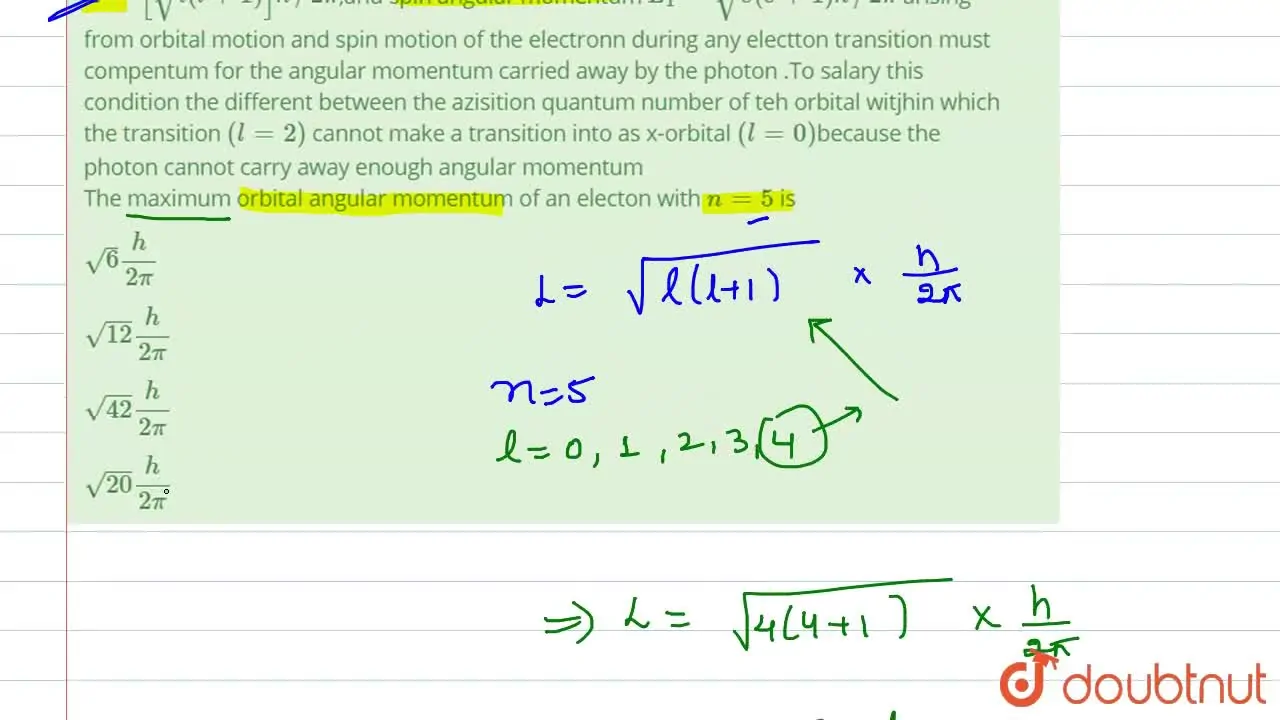It is tempting to think that all possible transition are permissible and that an atomic spectrum arises from the transition of an electron from any initial orbital to any other orbital .However this is not so because a photon a photon has as intrinsic spin angular momentum of √2h/2π corresponding to S=1 although it has no charge and no rest mass
On the other hand , an electron has got two type of angular momentum: orbital angular momentum
L=[√l(l+1)]h/2π,and spin angular momentum L1=√s(s+1)h/2π arising from orbital motion and spin motion of the electron during any electronic transition must compensate for the angular momentum carried away by the photon .To satisfy this condition the different between the azimuthal quantum number of the orbital within which the transition take place must differ by 1.thus, an electron in a d-orbital (l=2) cannot make a transition into as s-orbital (l=0)because the photon cannot carry away enough angular momentum
The maximum orbital angular momentum of an electron with n=5 is
There will be no change in the orbital angular momentum of electron athough the emitted photon has angular momentum
There will be change in the orbital angular momentum whereas the emitte photon has to momentum
Δm1valuee between 4s1 and 3s is not zero , which is an important selection slection rule for allowed transition
In 4s and 3s orbitals the wavelength of the electeron wave n=5 is
The correct Answer is:A
a. It does not involve any change in the value of l value of l should change by ±1
b. There will be no change in angular momentum because photon have angular momentum
c. Δm for 4s and 3s is zero
d. Wavelength of electron wave are not the same because n value is difference
Related Playlists
- BOOK - CENGAGE CHEMISTRY ENGLISHCHAPTER - ATOMIC STRUCTUREEXERCISE - Exercises Multiple Correct45videos
ATOMIC STRUCTURE
- BOOK - CENGAGE CHEMISTRY ENGLISHCHAPTER - ATOMIC STRUCTUREEXERCISE - Exercises Single Correct127videos
ATOMIC STRUCTURE
- BOOK - CENGAGE CHEMISTRY ENGLISHCHAPTER - ATOMIC STRUCTUREEXERCISE - Exercises (Subjective)52videos
ATOMIC STRUCTURE
- BOOK - CENGAGE CHEMISTRY ENGLISHCHAPTER - APPENDIX - INORGANIC VOLUME 1EXERCISE - chapter-7 Single correct answer1videos
APPENDIX - INORGANIC VOLUME 1
- BOOK - CENGAGE CHEMISTRY ENGLISHCHAPTER - CHEMICAL BONDING AND MOLECULAR STRUCTUREEXERCISE - Archives Subjective15videos
CHEMICAL BONDING AND MOLECULAR STRUCTURE
Similar Questions
It is teming to think that all possible transituion are permissible and that an atomic spectrum series from the transition of an electron from any intial orbital to any other .However this is not so because a photon a photon has as intrinsic spin angular momentum of √2h/2π corresponding to S=1 although it has no charge and no rest mass
On the other hand , an electron has got two typwe of agular momentum orbit angular momentum
L=[√l(l+1)]h/2π,and spin angular momentum L1=√s(s+1)h/2π arising from orbital motion and spin motion of the electronn during any electton transition must compentum for the angular momentum carried away by the photon .To salary this condition the different between the azisition quantum number of teh orbital witjhin which the transition (l=2) cannot make a transition into as x-orbital (l=0)because the photon cannot carry away enough angular momentum
The maximum orbital angular momentum of an electon with n=5 isView SolutionThe orbital angular momentum of an electron in 2s-orbital is
View SolutionThe orbital angular momentum of an electron in 2s-orbital is
View SolutionThe orbital angular momentum of an electron in 2s orbital is ………
View SolutionThe orbital angular momentum of an electron in 3s-orbital is :
View SolutionThe orbital angular momentum of an electron in a d-orbital is:
View SolutionThe minimum orbital angular momentum of the electron in a hydrogen atom is
View SolutionAngular momentum of electron in p orbital is :-
View SolutionThe orbital angular momentum of electron in 4s orbital of H atom is ……….
View SolutionFor a d-electron, the orbital angular momentum is :
View Solution


